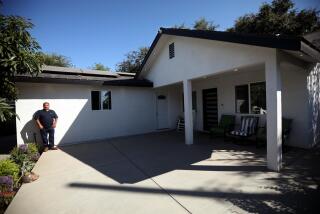4 Area Counties Among Population Gain Leaders
WASHINGTON â Fueled by a continued increase in births, a steady march of new immigrants and a robust economy, four Southern California counties were among the 10 nationwide that gained the most residents last year, according to U.S. census figures released Tuesday.
Population growth in Orange, Los Angeles, San Diego and Riverside counties exceeded growth in virtually all of the nationâs 3,142 counties between the summers of 1996 and 1997, the new estimates showed.
Orange County had the fourth-largest gain nationally, up 54,733 for a total of 2.67 million residents. It is now the sixth-largest county in the nation and the third largest in the state, but closing in on the second largest, San Diego.
Los Angeles County, the nationâs most populous, saw a net gain of 61,623 people during the year, bringing its population to 9.14 million in the federal count. In sheer numbers, the countyâs growth was surpassed only by that of Maricopa County in Arizona, which includes Phoenix and grew by 82,789 residents.
San Diego County was up 45,447 to 2.72 million and Riverside County was up 33,113 to 1.44 million, coming in fifth and seventh, respectively.
While the numbers are a sign of a strong economy, they are a harbinger of problems to come if the state does not prepare for more people. Everything from roads to air quality to the water supply could be threatened, experts warned.
âThis is just another wake-up call,â said Jack Kyser, chief economist at the Economic Development Corp. of Los Angeles County. âItâs good news for the business community, but bad news for government and people who have to worry about infrastructure. This is solid evidence of growth, and weâve got to plan for it.â
Michael Dear, director of USCâs Southern California Studies Center, cautioned that âthe debate has to shift now to how to accommodate growth and how to preserve the environmental quality that we have left in California.â Otherwise, he said, some of the things that attract people to the region may disappear.
In percentage terms, the growth experienced by the regionâs counties was relatively small--ranging from about 1% to 2%--because Southern California had so many people to begin with. But the actual numbers of new residents far surpassed most other regions.
âMore Californians are staying put and a lot of people who left [in recent years] are coming back,â said Linda Gage, chief of demography research at the state Department of Finance, which handles census data. âTypically as people get older, they move back to where they grew up, where they went to college or to where their children are. But we are finding that people of working age are moving to California.â
Indeed, the state recently reported that for the first time since 1990, more people were moving to California than were leaving it, reversing an exodus of residents trying to escape the crippling recession.
Even during that exodus, the state had a net gain in population, largely because of immigration and a steady birthrate. Still, the large-scale departure of people during their prime earning periods had many officials worried.
Now, some of the people and businesses who fled to states such as Washington, Oregon, Idaho, Nevada and Montana are coming back, federal experts said, citing a corresponding population slowdown in those areas.
âThe rest of the West can breathe easy,â said Marc Perry, a Census Bureau demographer. âA couple of people from Montana told us their state couldnât have taken [the continued arrival of Californians]. It was absolutely unsustainable growth.â
While California counties showed steady growth in the new census report, population booms occurred elsewhere in the nationâs Sunbelt. The nationâs fastest-growing county was Douglas, south of Denver in Colorado, which saw its population surge by 13% between July 1996 and July 1997.
Overall, Colorado and Georgia each had three of the 10 fastest-growing counties nationwide in percentage terms while counties in the North and East continued to stagnate or lag.
The one exception to this trend was Lincoln County, S.D., near Sioux Falls, which grew nearly 10%, probably because the booming Gateway computer company is headquartered just across its border, demographers said.
California as a whole grew by 1.3% in 1996-97, faster than the national average growth of 0.9%.
The California numbers track with recent predictions that there will be 18 million more people in the Golden State by 2025--about the equivalent of the entire state of New York moving in.
âWe went through a very dark period when nobody could find a good thing to say about California, and now people are realizing there is gold in them thar hills,â Kyser said.
Demographers say the new growth figures suggest that, especially in Southern California, new residents are following jobs as the region explodes with multimedia and technological industries and one of the largest concentrations of manufacturing in the country.
The population growth that Southern California experienced over the last year has been a pattern all decade long. The Census Bureau figures show a consistent rise in the number of residents in every county in the region during the seven years after the 1990 census.
At the start of the decade, Los Angeles Countyâs population was 8.9 million, and it has grown 3.2% since then, according to the federal tally.
The new figures still rank San Diego as the second-largest county in the state (and fourth-largest in the nation), but Orange County is running a close third among Californiaâs 58 counties.
Since 1990, San Diego County has grown 9%, from 2.49 million to 2.72 million; Orange County has grown 11%, from 2.41 million to 2.64 million.
In other parts of the region, the 1990-97 figures show that:
* Ventura County grew 8.5%, from 669,000 to 726,000, making it the 12th-largest county in the state and 62nd-largest in the nation.
* San Bernardino County grew 14%, from 1.4 million to 1.6 million, making it fourth-largest in the state and 13th-largest in the nation.
* Riverside County grew 24%, from 1.17 million to 1.44 million, making it the sixth-largest in the state and 18th-largest in the nation.
* Kern County grew 15%, from 545,000 to 629,000, making it 14th-largest in the state and 80th in the nation.
* Santa Barbara County grew almost 6%, from 370,000 to 390,000, making it 18th-largest in the state and 144th in the nation.
The same Southern California counties that topped the charts in new residents also led in the creation of jobs last year, Kyser said.
âWe are hearing more and more stories of people who moved their businesses to other states and have come back after finding the grass was not quite as green as had been made out,â he said.
Times staff writer Larry Gordon contributed to this story.
More to Read
Sign up for Essential California
The most important California stories and recommendations in your inbox every morning.
You may occasionally receive promotional content from the Los Angeles Times.










